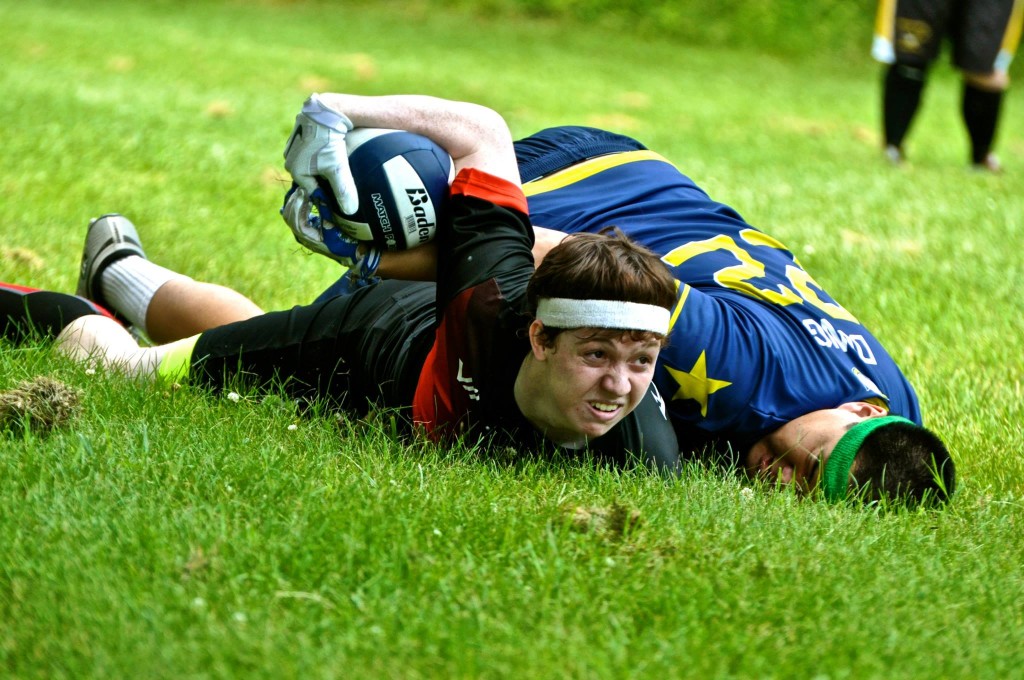- Rule, Britannia, no more?
- Unpopular Opinions: US Quadball Cup 2023
- Proven Contenders: University of Virginia
- Proven Contenders: Rutgers University
- Proven Contenders: University of Michigan
- Proven Contenders: Creighton University
- Different Perspectives: A Look Inside USA Ultimate
- Antwerp QC, Much of Belgian Core, Leaves Competitive Quidditch
New York Titans 2-1 After First Match Series
- Updated: June 30, 2015
BY ALEJO ENRIQUEZ
Coming into this series, the New York Titans were heavily favored due to their beater topline and depth. Without an inherent chemistry advantage to cover for roster weaknesses, Washington was rated by most as the underdog going into this series, though no one could fault the team’s preparation (players were spotted reading Attack on Titan the day before the series). The Admirals came out playing hard, winning their first game which was competitive the whole way, but as with many situations where a team’s depth is a problem, fatigue set in and the last two games were Titanic dominations (had to get it out of the way early, you understand).
Match One: Admirals 130*, Titans 110
This game was close and competitive from the initial brooms up. By the 6-minute mark, the score was 20-20 and many of each team’s seven drives were killed by good beating. From there, the Titans slowly began to pull away, with the score reading 80-40 at the end of the seeker floor. The game was actually closer than the score suggested, as on no fewer than three occasions during this game did a Washington chaser have a quaffle bounce off a hoop for no goal, followed by a turnover. This is a remarkably high number for one game and suggests, among other things, that the Admirals have a good starting point to improve their chaser play. The Washington chasers also struggled with passing, giving up several unnecessary turnovers from mishandled passes, and at least one goal was off the outstretched fingertips of a chaser leaping for an overthrown pass. Washington’s beaters in particular were key to keeping this game close, forcing 15 turnovers to New York’s eight over the course of the game. Washington’s underrated beater corps really delivered in this game. One of the most striking illustrations of this is that Anna Leonard played 15 drives, the most on her own team, without ever once giving up control, while beating with 100% accuracy on nine shots, many of which were medium- or long-range.
Washington’s chasers missed numerous opportunities, the most egregious of which was a fast break by an Admiral with plenty of green grass and only one tagging-in keeper in front of him, yet the keeper was able to track the Admiral’s movement and blocked a short-range shot. Setting aside the poor discipline of straight-line charging at a defended hoop (and not weaving to avoid long beats from behind), whatever happened to dunking?
Somehow, despite the missed opportunities, Washington clawed its way back into a tie game (and was the first to get to triple digits), due to two separate three-goal runs to level out the game. The first, beginning just over a minute after the end of the seeker floor, was over a 2-minute span that also included a yellow card for a Washington chaser, and were all fast-rushing attacks that did not incorporate passing. The second and ultimately game-saving, three-goal run was just 1 minute in length, in which Ricky Nelson (who had been resting for much of the game) and the seeker game swallowed up the attention of both the Titans’ beaters. Nelson, oft-mentioned in analysis coming into this game, may have helped make the difference, as the combined beater effort was good enough to keep Washington in the game, and a heroic snitch pull by Darren Creary closed the game out with a surprise win by the Washington Admirals.
Match Two: Titans 160*, Admirals 50
If any analyst in the know last week had been asked what might happen next after a spirited Washington first win, I suspect most would express concern that the Admirals might have emptied the gas tank too soon, and, indeed, this appears to be the case. After an exchange of goals at brooms up, four drives each stalled out in a flurry of bludgers and bad passes from both sides before the Titans scored three times in a row with each Admiral counterattack ending with a near-miss or shot that was beat before the goal. With a fifth goal for New York, the game began to appear out of reach, and what followed was an incredible 20 drives (10 for each) with no goals as Washington’s desperation mounted with every long hoop pass into traffic (and there were many of those). It is certainly not the case that the Admirals gave up in the least, and their frustration is understandable given their string of apparently bad luck: two short-range shots were painfully near misses, one rocket pass to a perfectly positioned hoop chaser that went right through her fingers, a dropped quaffle on a bludger block that was too slowly picked up, and, as already mentioned, four passes into traffic that resulted in turnovers. Washington even had bludger control for some of this series, and yet seemed to catch all the unlucky breaks.
With the score still 50-10 at 17 minutes of playing time (which could easily have been 50-40), the Admirals, or, more particularly, Beto Natera made a crushing mistake: a heavy, charging hit on a New York chaser leaping to try and catch an overthrown quaffle. With a straight red card for hitting a defenseless receiver, Washington was down a chaser for 2 minutes, and blatantly tried to run down the clock to get its numbers replenished, but still gave up another goal on the power play. A few possessions later, a foul at the hoops from yet another long-distance pass into traffic finally gave the Admirals a second goal, but it was small comfort to be down 60-20 with the seeker floor’s end only a minute away.
A total of eight goals were scored before the seeker floor ended. What happened next, in the intervening 8 minutes between the seeker release and the snitch pull, could only be described as a blood bath, with 10 more goals scored on only 13 drives. New York, in fact, scored on seven of its eight drives after the snitch battle began, made more remarkable by the fact that Washington still had a beater on defense for a number of these drives. Such a defensive implosion has many causes, from Nelson being assigned solely to the snitch game, to the relentless tackle-breaking ability of the New York chasers, to the fast and loose style these teams were playing all game in the first place conducive to fast breaks. Average drive time was substantially shorter in this series than the two series played by Indianapolis, and the resulting wear on the players, especially the Admirals, was undeniable. The final snitch pull by Andrew Zagelbaum felt like a mercy ending to a game that had spun completely out of control.
Match Three: Titans 150*, Admirals 50
Make no mistake, the Admirals did not give up on this series. The initial run-up crew showed feisty spirit and managed a takeaway from the initial Titans pickup of the quaffle. Unfortunately for Washington, the series seemed to pick up where it left off with missed quaffle opportunities, poor passes at the hoops, and a slowly building lead for the Titans. The game was 70-30 when another red card hit for Washington (this time a double-yellow on beater Natasha Conerly) just as the seekers were getting ready to enter the game. A torrent of New York goals followed, putting the game completely out of reach. By this point the Admirals were sapped by the heat and the vigor they had played the first two games with as well as the Titans’ suffocating beater play. Zagelbaum’s snitch pull seemed almost an inevitability.
Final Grades and Parting Shots
NEW YORK TITANS: B+ It was “suggested” I award an A- to this team, but as a college professor, I follow the simple rule of grade the game, not the name, and I saw too many overthrown passes and bludger turnovers, even on a clearly gassed Admirals team, to award any type of A. While the dominance was there as advertised down the stretch, no one would mistake this team for a polished engine, allowing three-goal runs on multiple occasions to essentially throw the first game up for grabs and having a lot of lucky breaks go their way throughout the second game before salting the third one away. Many of the team’s fundamentals were superior, including tackling, reading beater coverage and maintaining bludger control, but there is still some work to do to contend for a title. Good news for the Titans, however: consistency comes from experience, and they are bound to get plenty of it in the next month.
WASHINGTON ADMIRALS: C To have one shot bounce off a hoop may be bad luck, to see it five times sounds more like carelessness. The Admirals outplayed the expectations set for them by the Quidditch Intelligentsia but heart will only take you so far, and it does not really get the best mileage. Still, by relentlessly pressing offensive drives they demonstrated a good diversity of plays (compared to Detroit, with only two assists on nine goals in its best-played game, the Admirals had four assists on their 10 goals) and their beating game is clearly well-tuned for covering weaknesses in their chasing defense. Unfortunately, the flip side of the cozy relationship between the chasers and beaters was that when the beaters were otherwise engaged, the chaser defense left a lot to be desired. Broken tackles and unblocked shots were substantially more noticeable on the Washington defense, and the coaching staff would be wise to address fundamentals on both sides of the ball, both in tackling and in the passing game.
PARTING SHOT: Both teams clearly have their work cut out for them in building chemistry going forward. It is very easy to get on the cases of both sets of chaser for overthrown passes and missed shots, but it is easy to underestimate the role that practice plays in programming the cerebellum (the part of the brain responsible for managing motor functions). With more weeks of practice, the chasers of both teams should have a better conception of how their teammates pass, whether they are likely to pass into traffic, how hard they throw on passes to hoops, and so forth. After scoring six Indianapolis games, my own expectations for what a refined passing attack looks like have been raised considerably, as I charted very few dropped passes and blocked close-range shots in those games from the Intensity side. It will be an interesting experience watching to see whether the Titans and Admirals can get up to that refined level of cooperation within the next month.
Gratitude is owed to my colleague Joshua Mansfield for his excellent beating analysis, upon which I have leaned on in this piece.
Got a comment? Let me know! Twitter.com/prions is the place.





